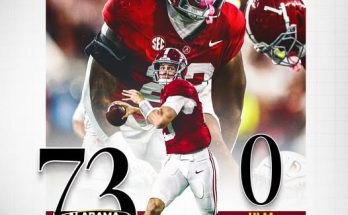In a moment that will be etched into sports history, the Alabama Crimson Tide Cheerleading Squad achieved the unthinkable and roared their way into the global spotlight. Crowned the world’s best by ESPN following a record-breaking and electrifying performance, the cheerleaders of Alabama shattered the conventional expectations of sideline spirit and ascended into the realm of elite international athleticism. It was a spectacle that not only captivated a national audience but also mesmerized viewers from all corners of the globe, leaving fans, judges, and commentators awestruck at a display described by ESPN as “a showcase of power and precision—Alabama Crimson Tide cheerleaders redefine excellence on the world stage.” What unfolded was more than just a routine; it was a bold declaration of dominance, artistry, and unity that shook the foundations of competitive cheerleading.
The performance took place on a historic night during the Global Cheer Summit, an annual event that brings together the best cheer programs from across the world. With national champions from countries like Japan, Canada, the UK, Australia, Brazil, and South Korea gracing the mat, expectations were already sky-high. But what Alabama delivered was not just about flawless technique—it was about storytelling through motion, passion through posture, and a synergy that felt almost otherworldly. As the lights dimmed and the crowd hushed, the Tide erupted onto the stage with a fire that was immediate and impossible to ignore. From the first tumbling pass to the final towering pyramid, they commanded the room with the confidence of world champions and the humility of disciplined artisans.
There is a reason Alabama is revered in collegiate athletics, and the cheerleading squad’s historic feat solidifies that reputation across new horizons. Their performance didn’t merely check the boxes of technical requirements; it redefined them. High-flying stunts were not just executed but sculpted with sculptural grace. Complex basket tosses that would shake even seasoned judges were performed with razor-sharp synchronicity. The transitions between formations were as smooth as a symphonic crescendo, building in emotional weight as the routine progressed. This was not cheerleading as sideshow. This was cheerleading as center stage.
The energy in the arena was unlike anything the event had seen before. As Alabama’s squad hit their final pose—arms outstretched in perfect harmony, backs arched, expressions unflinching—the crowd erupted into a standing ovation that lasted well over two minutes. Judges, some known for their icy detachment, were visibly moved. Several international competitors approached the squad with handshakes, tears, and respectful bows. For Alabama, this was more than just a win. It was a transformation of perception, a storm that washed away outdated notions of what cheerleaders are capable of.
What makes this moment all the more remarkable is the journey that led to it. For years, Alabama’s cheer program has been known as a breeding ground for talent, dedication, and unyielding standards. Under the guidance of head coach Jennifer Wilkins, a former cheer champion herself, the program has quietly evolved into a powerhouse. Wilkins instilled not only the grit needed to withstand punishing training sessions but also the philosophy that every move has meaning. Her mantra—”We don’t just perform, we proclaim”—became the guiding star for a team that refused to settle for average.
Preparation for the Global Cheer Summit was rigorous. The squad trained for eight months in advance, balancing academics, athletic obligations, and relentless choreography rehearsals. Injuries were endured and overcome, routines revised dozens of times, and every member pushed beyond what they thought physically possible. Athletes had to perfect elite-level gymnastics skills, memorize lightning-fast choreography, and maintain the vocal clarity necessary to command attention even in stadiums packed with thousands. It was a test of body, mind, and spirit.
Their breakthrough moment came during the regional qualifiers when Alabama not only scored the highest points of the competition but also received a rare perfect execution score. That sent a ripple through the cheer community. Social media exploded with speculation, and highlight reels of the squad’s preliminary performance went viral, trending in over 15 countries. ESPN quickly picked up the story, deploying a feature crew to document the Tide’s journey to the world stage. The hype was massive—and Alabama didn’t flinch.
What sets Alabama’s routine apart is its innovative use of both space and emotion. Rather than simply dazzling with difficult tricks, the performance was choreographed to tell a story—a story of resilience, unity, and Southern pride. Every leap symbolized a battle won. Every lift was a tribute to those who came before. The soundtrack, a mash-up of hip-hop, orchestral strings, and classic Alabama fight songs, was custom-designed to reflect both heritage and modern flair. At one point in the routine, the team formed a living compass—each member rotating around a central flyer held twenty feet in the air, arms stretched like a cross. That image, captured by ESPN’s drones, became the defining symbol of the competition, plastered across magazine covers and sports networks around the globe.
The significance of this win for Alabama goes beyond athletic bragging rights. It represents a cultural shift. For too long, cheerleading has battled outdated stereotypes, often dismissed as ornamental or secondary. But in truth, modern cheerleading—especially at the collegiate level—is a highly demanding sport that combines dance, acrobatics, strength, flexibility, and strategic teamwork. Alabama’s win forces the global sports audience to reconsider what counts as elite performance. These athletes train with the same intensity and purpose as any football or basketball team. They deal with the same pressure, the same scrutiny, and in many cases, far fewer resources. But still, they rise.
ESPN’s recognition of Alabama as the world’s best cheerleading squad was not just a victory lap—it was an acknowledgement long overdue. The network dedicated a primetime segment to the team, and the phrase “Crimson Queens and Kings” quickly took hold online. Even athletes from other disciplines began to take notice. NFL stars, NBA players, and Olympians took to social media to offer congratulations and awe. LeBron James posted a story with the caption, “That’s not cheer, that’s dominance. Salute, Alabama.” Simone Biles called it “the most athletic routine I’ve ever seen.”
Back home in Tuscaloosa, the celebration was euphoric. Thousands gathered at Bryant-Denny Stadium to welcome the team home. Fireworks lit up the night sky. The University of Alabama declared the following Monday an unofficial “Spirit Day,” encouraging students and staff to wear crimson and white in honor of the cheer squad’s achievement. Even head football coach Kalen DeBoer attended the celebration, stating, “I’ve seen championships up close, but what this squad just did on the world stage? That’s a whole new level of Tide greatness.”
There are whispers now that this performance may redefine cheerleading’s role in future international competitions. Some are even pushing for cheer to be considered for a full-fledged Olympic sport, and Alabama’s performance may well be the spark that lights that fire. If cheerleading ever does make it to the Olympic stage, history will look back at this moment—the night Alabama reigned supreme—as the pivot point.
The impact is already being felt on campuses and cheer gyms across the country and around the world. Coaches are analyzing footage of Alabama’s routine, choreographers are borrowing their transitions, and young athletes are saying, “I want to be like them.” For a generation of cheerleaders who grew up dreaming of the sidelines, Alabama just gave them the keys to the center stage.
What makes this achievement so lasting is not just the medals or the applause, but the legacy it creates. Alabama didn’t just win—they inspired. They didn’t just perform—they transcended. Their artistry reminded us that greatness comes in many forms. Sometimes it’s a buzzer-beater shot or a goal-line stand. And sometimes, it’s a group of athletes standing shoulder to shoulder, defying gravity with every toss, and reminding the world that excellence is not defined by where you start—but by how far, and how fiercely, you rise.
The Alabama Crimson Tide Cheerleading Squad now stands as a global symbol of what is possible when passion meets preparation. Their journey was grueling, their unity unbreakable, and their moment unforgettable. In a world that often overlooks the art in favor of the obvious, Alabama roared with grace and proved that the heart of the Tide beats strongest when it’s lifting others into the sky.



